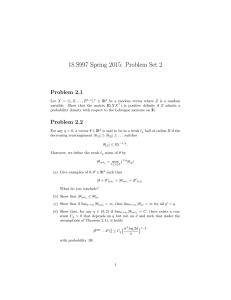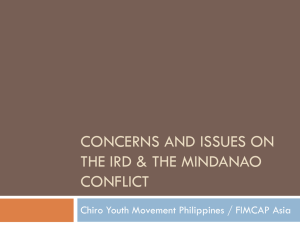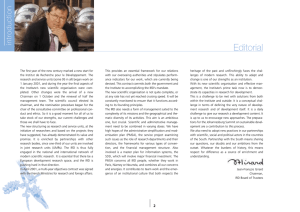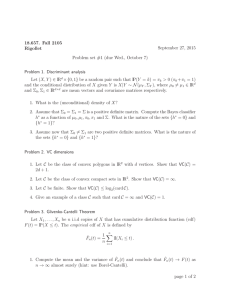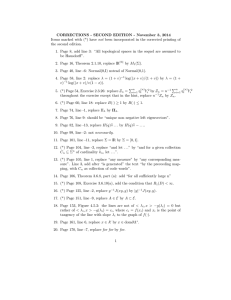R e s o u r c e s ... Palaeoclimate research in the Pacific
advertisement
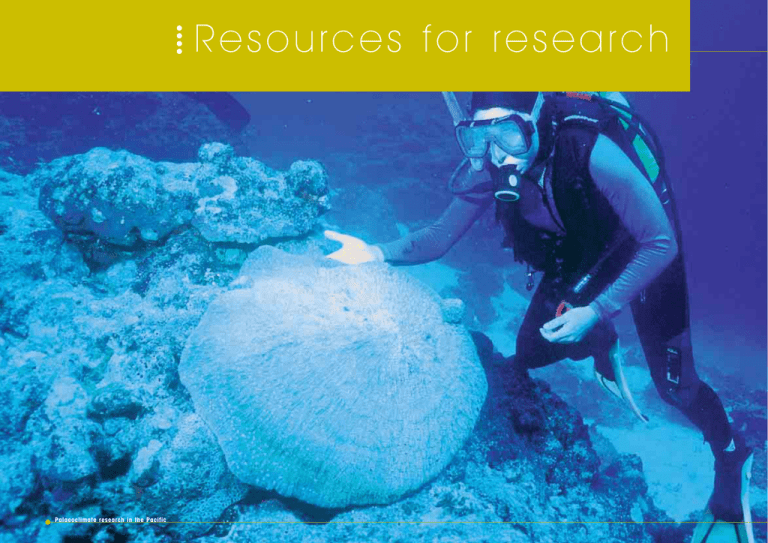
Resources for research Palaeoclimate research in the Pacific Annual report • 2006 ••• Scientific ••• Human equipment: pooled resources resources ••• Financial resources ••• Information systems Bats are a reservoir for Ebola virus, Gabon 47 Scientific equipment: pooled resources available to par tners Observing, studying and modelling the planetary environment requires increasingly sophisticated hardware. The life sciences and clinical research also now need facilities equipped with leading edge technology. To make the necessary tools available to the scientific community, the IRD has long applied the principle of pooling resources with its partners. The institute invests in many major equipment items, observation stations and technology platforms, applying the principle of open access for as many users as possible and training Southern researchers in the use of the technology. In 2006, thirteen shared laboratories and joint science and technology platforms were in use with local partners. ••• Environmental observation platform in the Amazon In French Guiana, the technology platform for monitoring the Amazonian environment by satellite offers researchers a fullyfledged observatory for studying the ecosystems of coast and forest and for monitoring water resources, fisheries and epidemiological indicators. ••• Environmental research observatories (OREs) The IRD is a partner in seven French national environmental research observatories (OREs) set up to monitor the environment and natural hazards. These observation and experimentation systems enable the scientific community to obtain regular, reliable data over long periods. This way they can better understand and model the functioning and dynamics of systems over the long term. www.ore.fr ••• Oceanographic survey ships In 2006 the Antéa, which is widely available to the scientific community, set sail for the Gulf of Guinea for the fourth EGEE survey (the oceanographic strand of the AMMA programme). The Alis, based in Nouméa, conducted nine physical, biological and geophysical oceanography missions in the New Caledonian lagoon and the western Pacific, including the Santo biodiversity survey in Vanuatu. L’Antéa ••• Clinical AIDS research centre in Senegal In Senegal, the regional centre for research and training in AIDS care at the Fann teaching hospital group in Dakar offers teams from North and South an optimum environment for conducting clinical, epidemiological and social science research. It is already providing long-term monitoring of a cohort of patients under treatment, and a trial by the French AIDS research agency ANRS designed to make retroviral drugs easier to take. ••• Clinical biology research laboratory in Benin In Benin, IRD research unit Mother and infant health in tropical environnements has cutting edge clinical laboratory equipment in place at the Institut des sciences biomédicales appliquées in the science faculty in Cotonou. This equipment means that scientists in Benin can push ahead with research on immunology, human genetics and the genetics of the malaria parasite in pregnant women and young children. ••• The ASTER and Artemis mass spectrometers An underwater glider is being used to study the speed and nature of ocean currents. It glides down in the currents to a depth of 1,000 m, takes water samples and transmits the data via satellite. In partnership with the Scripps Institution of Oceanography, USA, and the Pacific Marine Environmental Laboratory, USA, the glider has been used to study currents flowing into the Coral Sea in the western Pacific. ••• Seismometers on the ocean floor Ocean bottom seismometers or OBSs are miniaturised seismometers with waterproof casings that can be deployed on ocean floors down to depths of 7,000 m, to study local seismicity or to characterise deep geological features. The IRD has some thirty OBSs that are part of a national network set up with INSU (Institut national des sciences de l’univers) and Ifremer (Institut français de recherche pour l’exploitation de la mer). OBSs have been deployed in the Red Sea as part of the Encens survey, which is a joint project between Ifremer and the CNRS (Centre national de la recherche scientifique). Operations have also been conducted in Martinique, where OBSs are recording seismicity continuously. This latter project is in cooperation with the Institut de physique du globe. ••• Measuring seismic and volcanic hazards The portable absolute gravimeter is used in the field to take precise, absolute measurements of the Earth’s gravity field. The instrument was bought jointly with the IGN (Institut géographique national) and the Institut de physique du globe and is being used for research into seismic and volcanic hazards. At present it is helping to monitor movements of the Earth’s crust in northern Chile, one of the world’s most seismically active regions, where it is detecting magma transfers beneath active volcanoes. Annual report • 2006 ••• Underwater glider studies ocean currents Inaugurated on the site of the Arbois Mediterranean Europole in 2006, the ASTER acceleration mass spectrometer is used for measuring the cosmogenic isotope content of samples. It has many potential applications. In tectonics it can be used to determine rates of fault movement, in palaeoclimatology to date the retreat of glaciers and the polar ice caps, and in geomorphology to monitor the evolution of river networks. The Artemis mass spectrometer in Saclay, France, is used for measuring carbon 14 levels in samples. Among other purposes, it is being used to analyse sediments deposited at the leading edges of glaciers, so as to reconstitute their successive advances and retreats during the Holocene. ••• Tropical greenhouses In Montpellier, 2,000 m2 of greenhouses with controlled environments in terms of light, hygrometry, day length, temperature and confinement are available to the scientific community for research into plants of interest to Southern countries. Rice, coffee, palm species and casuarina are among the species being studied there. Gene transfer methods are employed by qualified teams. ••• Research and development information centre, Burkina Faso The CIRD (Centre d’information sur la recherche et le développement) in Ouagadougou is based on a partnership between the IRD, Cirad (Centre de coopération internationale en recherche agronomique pour le développement) and the French overseas development agency. It is proving a wonderfully useful documentation centre, especially for those needing access to electronic journals and the main international scientific databases. Sixteen thousand visitors – teachers, researchers, students and development professionals and partners – made use of its resources in 2006. Three IRD laboratories have been designated WHO collaboration centres, on nutrition, vector-borne diseases and retroviruses. The IRD has established health observatories in Niakhar and Dielmo in Senegal and at the Organisation de coordination pour la lutte contre les endémies en Afrique centrale (OCEAC) in Cameroon. 49 Human Resources The IRD employs 2,231 staff including 828 researchers, 1,013 engineers and technicians and 390 local staff. Their average age (excluding local staff) is 44-40 for women and 46 for men. ••• Parity engineer and technician grades will be incorporated in the 2007 programme. As regards internal promotion, 27 researchers and 34 engineers and technicians moved up a grade, and 10 engineers and technicians were promoted to researcher category. Nearly 40% of IRD staff are women. Few of them (23%) are in the researcher categories, most (56%) being engineers or technicians. The percentage of women decreases in the higher grades – only 16% of unit directors are women and the level of parity in the decision bodies remains low. Twenty-nine tenured staff retired in 2006, more than half of them researchers. The average age of those retiring was 63, for men and women alike. ••• Present on every continent The introduction of the constitutional by-law on budget acts had a major impact on the IRD’s human resources, as it must henceforth apply an official ceiling on job numbers and wage bill. The introduction of the Sorgho human resources management software at the start of the year has made a big difference to the Institute’s administrative management of staff, jobs, working hours and pay, speeding the management process and making it more flexible. Forty-three per cent of staff work outside Metropolitan France: 25% in Africa, 10% in the French overseas territories, 6% in Latin America and 4% in Asia. The strongest IRD presence in Africa is in Senegal and Burkina Faso; Brazil, Bolivia and Peru are the main Latin American countries for IRD research; and in the overseas territories, French Guiana and New Caledonia are the main focuses. In 2006, IRD staff performed 117 long-term missions of 2 to 10 months. Africa was the main destination for these (44%), while Latin America accounted for 34% and Asia for 16%. ••• Recruitment, mobility and retirements Competitive entry exams were held for 40 researcher posts. Thirty-seven researchers were recruited out of 506 candidates – 16 directors of research, 5 Grade 1 researchers and 16 Grade 2 researchers – including 7 women. There was a major internal mobility drive. In all, 94 engineers’ and technicians’ jobs were opened to internal applicants, giving staff new career prospects. Thirty-three posts were filled. The 2006 external competitive recruitment drive for ••• Modernising human resources management Teaching safety and hygiene awareness Pay New official regulations on “specific recompense for duties of collective value” allowed the Institute to pay this bonus to more staff in jobs with particular responsibilities in management, coordination or facilitation, especially heads of research or service units. Improving the careers of tenured staff To boost tenured staff careers and welfare provision, an agreement was signed between the civil service Minister and three trade unions (Protocol Jacob, 25 January 2006). Class C staff are the first to benefit, in terms of grading, pay and promotion. A compensatory bonus (€400 to €700) was introduced to award Class A and B staff for at least five years at the top of the top grade in their category. New system for temporary transfers The maximum duration of missions was raised from 2 months to 12, so that what used to be a special arrangement for long-term missions is now routine. The system of compensation for temporary transfers was improved and simplified, with higher ceilings and a harmonisation of the systems for Metropolitan France, the overseas territories and other countries. ••• In-service training The IRD pursued its in-service training policy to help staff in setting up institutional projects. This includes training to use the Sorgho software, apply the constitutional by-law on budget acts and implement quality management. A special effort went into training in professional risk prevention, health and safety. •••••• Contact: ddp@ird.fr Annual report • 2006 Staff Age pyramid Tenured staff Men Age Women Researchers Engineers and technicians Local staff 66 65 64 63 62 61 60 59 58 57 56 55 54 53 52 51 50 49 48 47 46 45 44 43 42 41 40 39 38 37 36 35 34 33 32 31 30 29 28 27 26 25 24 23 22 21 20 19 50 40 30 20 10 TOTAL 22% Social sciences Researchers Engineers and technicians Local staff TOTAL Researchers Engineers and technicians Universe sciences 1583 648 2231 % Women % Total 633 445 270 76.4 43.9 69.2 195 568 120 23.6 56.1 30.8 828 1013 390 1348 60.4 883 39.6 2231 2002* 2003* 2004* 2005* 2006** 38.8% 32.2% 36.7% 30.7% 33.8% 28.8% 35.14% 24.45% 37% 26% Long-term missions 2002-2006 0 0 10 20 30 40 50 2002 2003 2004 2005 2006 Africa América Asia/Pacific Europe 15 16 4 1 38 33 8 2 42 45 20 8 60 60 32 3 52 40 19 6 TOTAL 36 81 115 155 117 Source : data from the Sorgho software package at 31 December 2006 Staff by major region Engineers and technicians, by activity branch 4% 1% Chemistry and science of materials 504 Mathematics Africa (22.6%) 5% Medicine 3% 1275 Metropolitan France (57.1%) 142 America (6.4%) 23% Life sciences 38% Life sciences Asia/Pacific (3.8%) 149 French overseas territories (6.7%) 76 Europe (3.4%) 4% Engineering sciences and scientific instrumentation 6% Human and social sciences 10% Data processing and scientific computing 85 Engineering sciences 24% 828 1013 390 *Up to 2006, percentage calculated from budgeted posts ** In 2006, percentage calculated for the staff of the Institute at 31 December 2006 2% Human sciences 14 244 390 Staff on assignment outside metropolitan France Physics 4% 814 769 Men Researchers by discipline 1% Total Staff by gender Staff Chemistry Non-tenured staff 39% Scientific and technical management 9% Documentation, publishing, communication 5% Property management, logistics and prevention 51 Fi n a n c i a l r e s o u r c e s 2006 was the first year in which finances were managed by a fully integrated information system, operating costs and pay being managed by a single software package, Sorgho. The Institute’s budget was €201.65 million, including €169.81 million in government grants (84.2%), €12.7 million in contract income and €2.38 million in miscellaneous income. The balance was covered by €16.76 million from the Institute’s working capital. Staff pay accounted for 71% of the budget (€135.32 million, of which 22% were for expatriation expenses). ••• Spending focused on priorities in research for development Under its new 2006-2009 objectives contract, the IRD is committed to an ambitious, coherent policy of matching its resources to its priorities, which are to: • support the Institute’s new mission as lead agency in research for development; • give more resources to the research and service units and encourage them to reorganise and integrate into the scientific community; • continue to host expatriate researchers and provide training and support for Southern scientific communities; • proactively open up to potential partners, particularly by concentrating credits for property and capital equipment on joint operations with universities and other research bodies; • ensure sufficient management resources for the scientific fleet, in cooperation with the other research institutions concerned. ••• Resources for the research and service units The units directly receive more than 60% of the Institute’s financial resources. They account for 69.9% of staff costs and 38.1% of the operating and investment budgets. The IRD reaffirmed its priority focus on expatriation by devoting € 30.6 million to that budget item. ••• A major contribution to shared capital equipment Investment in major capital equipment amounted to €3.53 million – an increase of 30%. The modernisation of the scientific fleet began; this is now managed by a joint venture, GENAVIR. It includes refurbishment of the ocean-going survey vessel Antéa at a cost of €2.11 million. The Institute’s self-financing capacity still allowed for other investments such as setting up an “emerging diseases” platform on the Mahidol-Salaya university campus in Thailand, renovating the mobile accelerometer network in partnership with Insu and jointly purchasing a mass spectrometer with the CNRS. The €1.23 million in contributions to partnerships illustrates the IRD’s commitment to its partners, both French research bodies and international organisations. ••• Major investment in the property asset base Amounts spent on maintenance and building work doubled in 2006, to a total of €2.54 million: • completion of the centre for biology and population management (CBGP) in Montpellier; • construction of a soil confinement laboratory on the Ensam campus; • participation in the creation of an oceanography cluster of European scope, under the fourth State-Region development plan for Brittany; • extension of the Île-de-France centre’s reception wing. ••• Contract income on the rise The IRD’s success rate in proposals submitted under National Research Agency (ANR) bid processes confirmed its leading position in a number of fields. Contracts obtained by IRD teams in 2006 represented a financial envelope of more than € 6million*. The IRD’s mission of stimulating the French scientific community to work on issues important for development was strengthened when it was given lead agency status in that connection. The Institute has already acted as coordinator or manager for 20 scientific projects conducted by (non-European) international partnerships and costing more than €1 million over the project’s lifetime. * Contracts for an average of three years. Information systems The first phase of the information systems master plan was completed in 2006 with the successful launch of payroll management by the Sorgho software package and the introduction of a new mission management system. Now the 2006-2009 phase begins. A key aim is to use software to ensure compliance with the objectives contract. Part of the cost (€ 7.5 million) will be covered from working capital. Of the seven goals in the information systems master plan, the considerable increase in the use of scientific software is well under way and is well received by staff. Expenditure of research and services units (€M) 0.37% 0.69 Expenditure of the IRD, by type (€M) Income from applications of research 6.88% 2.04% 12.70 3.91 Research contracts Programmed investment By research department Staff Operating costs and investment Total Earth and Environment Department Living Resources Department Societies and Health Department 30.47 31.50 33.12 6.27 6.91 6.68 36.74 38.41 39.80 TOTAL 95.09 19.86 114.95 Staff Operating costs and investment Total 0.68% 1.26 Other income and subsidies 92.06% 169.81 27.24% By research department 52.12 Operating costs and non-programmed investments State grant 70.72% 135.32 184.46 M€ Personnel • Natural hazards, climate and non-renewable resources • Sustainable management of Southern ecosystems • Continental and coastal waters • Food security in the South • Public health and health policy • Globalisation and development 9.03 1.49 10.52 17.66 19.38 16.32 15.20 17.50 3.49 4.05 3.82 4.28 2.73 21.15 23.43 20.14 19.48 20.23 TOTAL 95.09 19.86 114.95 191.35 M€ Income from research contracts, by origin (€M) Expenditure of cross-cutting functions (€M) 28.50% 7.64% 0.97 International institutions 3.62 Expenditure by major region (€M) Other partners (public and private sectors) 21.34% 2.71 French Ministries and territorial authorities 8.36% 15.99 5.48% 10.49 Asia Latin America 0.53 % 8.03 % 1.01 1.02 Other countries 18.70% European institutions 27.87 % 3.54 French public establishments 6.61 % 0.84 National Research Agency Annual report • 2006 Resources of the IRD (€M) 35.78 Africa and Indian Ocean Capacity building support Consulting and industrial liaison Scientific information and communication International relations Outreach activities Scientific evaluation In-service training Contributions to partnerships Naval resources Other major scientific equipment TOTAL Staff Operating costs and investment Total 0.64 0.65 4.75 8.58 2.24 0.30 0.00 0.03 1.02 0.00 2.43 0.55 2.04 3.19 0.22 0.35 0.93 2.13 5.03 0.79 3.07 1.20 6.79 11.77 2.46 0.65 0.93 2.16 6.05 0.79 18.21 17.68 35.87 11.11% 21.26 12.70 M€ Income from research contracts, by origin (€M) Earth and Environment Department Living resources Department Societies and Health Department Other Partnerships, contracts managed by the IRD* Total in budget Transferred to partners off-budget TOTAL 55.83 % French overseas territories 3,63 3,20 4,07 0,99 0,81 12,70 2,22 14,92 106.83 191.35 M€ Metropolitan France Expenditure of support functions (€M) Staff Operating costs and investment Total 1.08 7.21 2.22 12.79 14.05 3.16 Social action Information systems Real estate operations Territorial representations * Central services Other 0.00 2.47 0.00 7.68 11.87 0.00 1.08 4.74 2.22 5.11 2.18 3.16 TOTAL 22.02 18.49 40.51 *France and overseas territories (representation abroad is classed under “international relations” in table 2, cross-cutting functions. * As part mainly of Europe, ANR or GIS contracts 53
